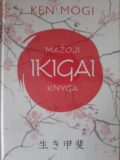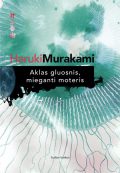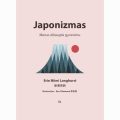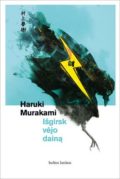 Authors:
Authors:
Bracht, Mary Lynn
Translated by:
Kapočiūtė, Anita
Translated from:
English
Published on:
2019
“Comfort women” are little girls and women, who were forced to be sex slaves by the Imperial Japanese army. These events occurred during World War 2 in Japan occupied countries. the name of “comfort women” is translated from the Japanese word ianfu (慰安婦).
“White chrysanthemum” is written by Korean-American writer Mary Lynn Bracht. Although the author now lives in London, she grew up in the United States, in a large community of Korean emigrants. After a 2002 visit to a South Korean village where her mother grew up, and the first time she heard of “comfort women,” the writer decided to depict their life endured in slavery. The novel is based on the history of Japan, Korea and “comfort women”. The book uses fictional events, characters, places and names. The action of the novel intertwines between the perspectives of two sisters. The time zone is divided between Emi’s life in 2011 and Hana’s living in the 1940s. More
 Authors:
Authors:
Mogi, Ken (Kenchiro)
Translated by:
Krištopaitienė, Daiva
Translated from:
English
Published on:
2018
“The Little Book of Ikigai” is an easy book to read, which conveys exotic Japanese everyday life philosophy and a way to find your purpose- ikigai. In this book author talks about the main five principles of ikigai, which should help readers to understand the importance to this philosophy in Japanese culture and in people‘s lives in general. ‚Ikigai‘ is a Japanese word that means pleasures and the meaning of life. Using Japanese cultural examples, such as, sumo, kodawari, Japansese tea ceremony, etc., author easily conveys the message, meaning and explains every principle of ikigai. More
 Authors:
Authors:
Murakami, Haruki
Translated by:
Čepulionytė, Gabija; Ignotienė, Jurgita
Translated from:
Japanese
Published on:
2018
“You can create a short story from the smallest detail – it’s like jazz improvisation, where the story takes me where it wants to go.”
Haruki Murakami’s mastery was revealed in a new light in which the details and small, almost visible strokes once again allowed the reader to stop, exhale and simply enjoy the masterpiece.
“The Blind Willow, a Sleeping Woman” is a collection of twenty-four stories written between 1980 and 2005. period. This work not only allows you to enjoy great literature, but also reveals how the writer’s tone changes over the years, what colors become brighter, and what fades. The collection generously expresses Murakami’s mastery of the writing form. From surrealism to everyday life, it demonstrates the ability to portray human experience in a variety of ways that can serve as instructive, compelling, or simply ridicule. More
 Authors:
Authors:
Longhurst, Erin Niimi
Translated by:
Puzauskaitė, Agnė
Translated from:
English
Published on:
2018
This book is divided into three chapters: Kokoro (Heart and Mind; 心), Karada (Body; 体), Shukanka (Habit Formation; 習慣 化). In the first chapter, the author talks about how one can discover his “ikigai” i.e. goal which leads the person forward. Every person’s “Ikigai” is different. It can be: work, love, nature, family and self-care. You may have already discovered your “Ikigai” but you haven’t realized it yet. It’s like fuel for a human motor without which it’s hard to get your feet out of bed in the morning. What follows is wabi-sabi, the ability to come to terms with the turmoil and temporality of life. The author herself mentions that of all the concepts mentioned in the book, this is the most difficult to explain. The original meaning of the word “wabi” is a sense of distance and loneliness, as well as the paradoxical beauty of imperfection. Meanwhile, “sabi” has several meanings: twisted, bent. But most of the time, it means the beauty of aging. So wabi-sabi is what is not complete, not perfect, and will not last forever. The first chapter is completed by More
 Authors:
Authors:
Murakami, Haruki
Translated by:
Čepulionytė, Gabija
Translated from:
Japanese
Published on:
2017
This novel is about a 21 year old guy, who studies biology and came back home for summer holidays. Having a lot of free time leads narrator and his old friend called “Rat“ spending a big portion of it in J‘s bar. There they just drink beer and smoke. The main character of the novel is quite a silent guy but he ponders about many different things. Most of his contemplations revolve around his three ex girlfriends, strange accidents, carnal love and his new friend who has lost one More
 Authors:
Authors:
Kang, Han
Translated by:
Šiaučiūnas-Kačinskas, Martynas
Translated from:
Korean
Published on:
2017
At first glance book ‘The Vegetarian’ may impose some skeptical thoughts to the reader, but with every page you read through it becomes increasingly clear that this is not a simple story about a woman who does not eat meat. The book is psychologically difficult with such topics as domestic violence and also philosophically challenging, raising questions about the boundaries of human virtue and lust. The extremely grotesque novel forces the reader to contemplate about various More
 Authors:
Authors:
Suzuki, Tadashi
Translated by:
Savickienė, Kristina
Translated from:
English
Published on:
2017
“Culture is the Body: The Theatre Writings of Tadashi Suzuki” is a book about both Western world and Japanese theatre base and traditions. Tadashi Suzuki, a director who analyzes different theatre genres and forms, compares traditional Japanese Noh and Kabuki theatre to Greek dramas, Chekhov’s works and modern dramaturgy. It is important to notice how the author is trying to portray the actual work and mindset of a director and natural acting. How directors work and interpret text and turn it into a play. More
 Authors:
Authors:
Hailji
Translated by:
Šiaučiūnas-Kačinskas, Martynas
Translated from:
Korean
Published on:
2016
The main character of a novel together with his wife comes to the seaside town to celebrate their 10th wedding anniversary. ( in the novel the name of the town is not mentioned, but for the character it is very well known and nostalgic.) At night, the man is suddenly arrested by the police and taken to an unknown place to testify for a professedly committing a murder. A novel begins in an oppressive and stress-filled room. A bright light pointing in his face, handcuffed hands and the only … More
 Authors:
Authors:
Kondo, Marie
Translated by:
Černiauskaitė, Lina
Translated from:
English
Published on:
2016
Marie Kondo is an organisational consultant and author. Ever since she was little Marie was interested in categorising and organising things. Now she consults people and organizations in how to adequately tidy up a work place or home and then how to keep it that way. “The Life-Changing Magic of Tidying-up” is the collected knowledge and experience of the author and is filled with practical advice and new perspectives.
More
 Authors:
Authors:
Harrington, Joseph D., Yokota, Yutaka
Translated by:
Stanaitytė-Karsokienė, Aušra
Translated from:
English
Published on:
2016
Yutaka Yokota (born in 1926) – is someone who survived incredible Japanese imperial navy experiment which is turning people into live torpedoes. ,,Kamikaze submarine” is about a historical witness Yutaka Yokota who became a Kaiten pilot. Kaiten is a torpedo, which is piloted by a live person so every kaiten pilot came in peace with the idea of dying. This book is about kaiten pilots everyday life, their preparations and wish to give up their lives for Japan.
More
 Authors:
Bracht, Mary Lynn
Authors:
Bracht, Mary Lynn 
 Authors:
Mogi, Ken (Kenchiro)
Authors:
Mogi, Ken (Kenchiro)  Authors:
Murakami, Haruki
Authors:
Murakami, Haruki  Authors:
Longhurst, Erin Niimi
Authors:
Longhurst, Erin Niimi  Authors:
Murakami, Haruki
Authors:
Murakami, Haruki  Authors:
Kang, Han
Authors:
Kang, Han  Authors:
Suzuki, Tadashi
Authors:
Suzuki, Tadashi  Authors:
Hailji
Authors:
Hailji  Authors:
Kondo, Marie
Authors:
Kondo, Marie  Authors:
Harrington, Joseph D., Yokota, Yutaka
Authors:
Harrington, Joseph D., Yokota, Yutaka